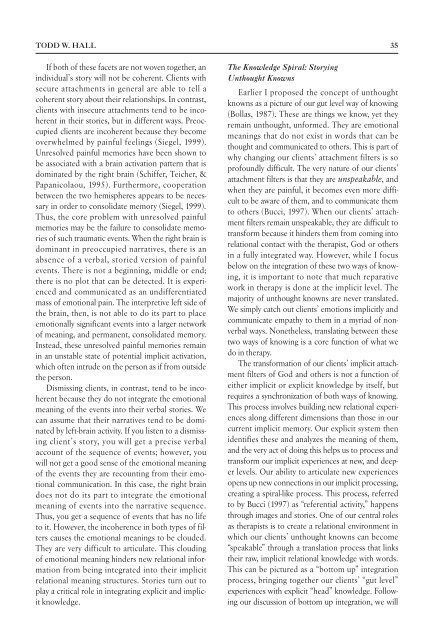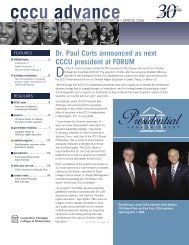Psychoanalysis, Attachment, and Spirituality Part II ... - Dr. Todd Hall
Psychoanalysis, Attachment, and Spirituality Part II ... - Dr. Todd Hall
Psychoanalysis, Attachment, and Spirituality Part II ... - Dr. Todd Hall
You also want an ePaper? Increase the reach of your titles
YUMPU automatically turns print PDFs into web optimized ePapers that Google loves.
TODD W. HALL 35<br />
If both of these facets are not woven together, an<br />
individual’s story will not be coherent. Clients with<br />
secure attachments in general are able to tell a<br />
coherent story about their relationships. In contrast,<br />
clients with insecure attachments tend to be incoherent<br />
in their stories, but in different ways. Preoccupied<br />
clients are incoherent because they become<br />
overwhelmed by painful feelings (Siegel, 1999).<br />
Unresolved painful memories have been shown to<br />
be associated with a brain activation pattern that is<br />
dominated by the right brain (Schiffer, Teicher, &<br />
Papanicolaou, 1995). Furthermore, cooperation<br />
between the two hemispheres appears to be necessary<br />
in order to consolidate memory (Siegel, 1999).<br />
Thus, the core problem with unresolved painful<br />
memories may be the failure to consolidate memories<br />
of such traumatic events. When the right brain is<br />
dominant in preoccupied narratives, there is an<br />
absence of a verbal, storied version of painful<br />
events. There is not a beginning, middle or end;<br />
there is no plot that can be detected. It is experienced<br />
<strong>and</strong> communicated as an undifferentiated<br />
mass of emotional pain. The interpretive left side of<br />
the brain, then, is not able to do its part to place<br />
emotionally significant events into a larger network<br />
of meaning, <strong>and</strong> permanent, consolidated memory.<br />
Instead, these unresolved painful memories remain<br />
in an unstable state of potential implicit activation,<br />
which often intrude on the person as if from outside<br />
the person.<br />
Dismissing clients, in contrast, tend to be incoherent<br />
because they do not integrate the emotional<br />
meaning of the events into their verbal stories. We<br />
can assume that their narratives tend to be dominated<br />
by left-brain activity. If you listen to a dismissing<br />
client’s story, you will get a precise verbal<br />
account of the sequence of events; however, you<br />
will not get a good sense of the emotional meaning<br />
of the events they are recounting from their emotional<br />
communication. In this case, the right brain<br />
does not do its part to integrate the emotional<br />
meaning of events into the narrative sequence.<br />
Thus, you get a sequence of events that has no life<br />
to it. However, the incoherence in both types of filters<br />
causes the emotional meanings to be clouded.<br />
They are very difficult to articulate. This clouding<br />
of emotional meaning hinders new relational information<br />
from being integrated into their implicit<br />
relational meaning structures. Stories turn out to<br />
play a critical role in integrating explicit <strong>and</strong> implicit<br />
knowledge.<br />
The Knowledge Spiral: Storying<br />
Unthought Knowns<br />
Earlier I proposed the concept of unthought<br />
knowns as a picture of our gut level way of knowing<br />
(Bollas, 1987). These are things we know, yet they<br />
remain unthought, unformed. They are emotional<br />
meanings that do not exist in words that can be<br />
thought <strong>and</strong> communicated to others. This is part of<br />
why changing our clients’ attachment filters is so<br />
profoundly difficult. The very nature of our clients’<br />
attachment filters is that they are unspeakable, <strong>and</strong><br />
when they are painful, it becomes even more difficult<br />
to be aware of them, <strong>and</strong> to communicate them<br />
to others (Bucci, 1997). When our clients’ attachment<br />
filters remain unspeakable, they are difficult to<br />
transform because it hinders them from coming into<br />
relational contact with the therapist, God or others<br />
in a fully integrated way. However, while I focus<br />
below on the integration of these two ways of knowing,<br />
it is important to note that much reparative<br />
work in therapy is done at the implicit level. The<br />
majority of unthought knowns are never translated.<br />
We simply catch out clients’ emotions implicitly <strong>and</strong><br />
communicate empathy to them in a myriad of nonverbal<br />
ways. Nonetheless, translating between these<br />
two ways of knowing is a core function of what we<br />
do in therapy.<br />
The transformation of our clients’ implicit attachment<br />
filters of God <strong>and</strong> others is not a function of<br />
either implicit or explicit knowledge by itself, but<br />
requires a synchronization of both ways of knowing.<br />
This process involves building new relational experiences<br />
along different dimensions than those in our<br />
current implicit memory. Our explicit system then<br />
identifies these <strong>and</strong> analyzes the meaning of them,<br />
<strong>and</strong> the very act of doing this helps us to process <strong>and</strong><br />
transform our implicit experiences at new, <strong>and</strong> deeper<br />
levels. Our ability to articulate new experiences<br />
opens up new connections in our implicit processing,<br />
creating a spiral-like process. This process, referred<br />
to by Bucci (1997) as “referential activity,” happens<br />
through images <strong>and</strong> stories. One of our central roles<br />
as therapists is to create a relational environment in<br />
which our clients’ unthought knowns can become<br />
“speakable” through a translation process that links<br />
their raw, implicit relational knowledge with words.<br />
This can be pictured as a “bottom up” integration<br />
process, bringing together our clients’ “gut level”<br />
experiences with explicit “head” knowledge. Following<br />
our discussion of bottom up integration, we will












![Download Guide [PDF] - Council for Christian Colleges & Universities](https://img.yumpu.com/37211849/1/190x245/download-guide-pdf-council-for-christian-colleges-universities.jpg?quality=85)



